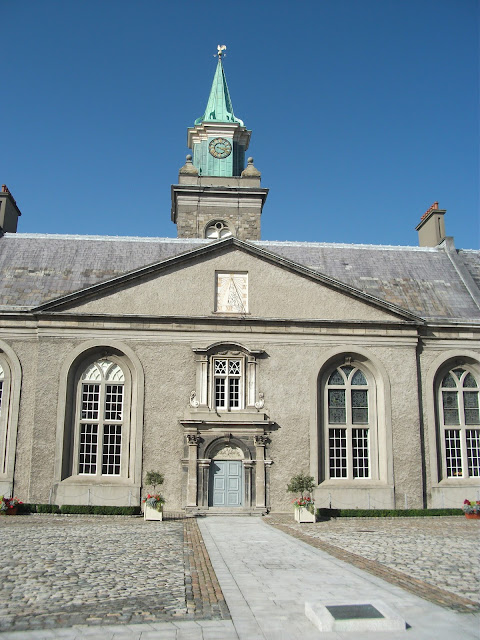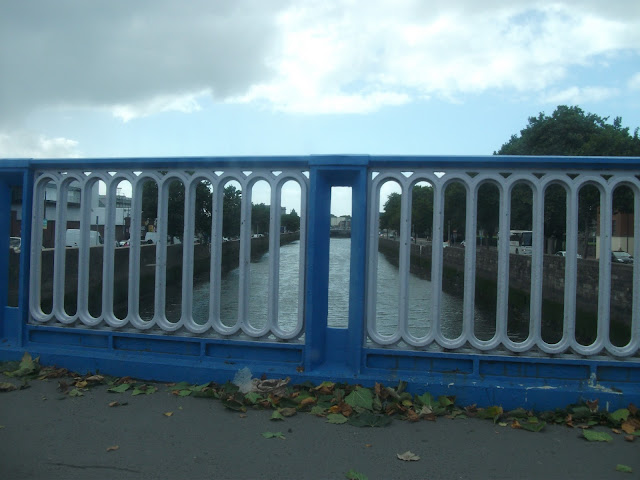Stroke of genius. We set off for the airport early to take a detour around the Casino House, which Martine had wanted to visit for a while. I had no idea what it was until we arrived:
The Casino was designed by Sir William Chambers as a pleasure house for James Caulfeild, 1st Earl of Charlemont. It is one of the finest 18th Century neo-classical buildings in Europe. The Casino, meaning "small house", surprisingly contains 16 finely decorated rooms, endlessly rich in subtlety and design. It is a remarkable building - both in terms of structure and history.
It truly is a tardis. Outside, it looks like a monument. Inside, it's a beautiful house.
 |
| The urns are hidden chimneys. |
 |
| Percy and Lion |
 |
| Someone crocheted it a mane! |
Everything in the house has meaning, from statues of Greek gods to the geometry of the floor. Above caught my attention: bull skulls. The day before, we drove past the back of The Custom House. Above the Custom House they have four bulls' heads, but full-flesh, rather than skulls.
Turns out the guy who designed The Custom House was the star pupil of the guy who designed the Casino. The skulls were a nod to the sacrifices of ancient Greece and the classical world, whereas the bulls were a nod the the rich beef exports of Ireland.
Oil cloths protect the floors, mirroring the colours and patterns below. They are made from woods from around the world: rosewood, pear wood, purple heart, mahogany, ebony, and one that's now extinct!
The door is deceptive. It looks unbelievably tall but it's a normal-sized door in a larger setting. It's made from grey oak to blend in with the stone.
When it was originally built, the sea was in further than it is now as they hadn't reclaimed the land. This view looked out across the coast, and then another lord bought the land in between. He had a row with James Caulfeild, who turned the road outside his property into a tole road so that he had to pay to get the building materials to his site. The second lord found a way around this by hiring a barge to transport the material across the bay. In retaliation, he built his house as tall and unsymmetrical as he could, to block Caulfeild's view and annoy him. It was known as Spite Crescent.
Caulfeild was himself an interesting character, having disappeared around the world for nine years, survived being poisoned by an Italian mistress, and marrying a local woman at the age of forty to prevent his brother inheriting his estate since he 'didn't like classical architecture' and threatened to change it.
 |
| Apollo in the Ceiling |
Along with false windows on the outside that don't look into any rooms, the glass in the windows is curved to deflect sunlight. This makes it harder for people to see in, but also stops the sun's rays from fading the silk wallpaper at the back. We were amazed that they knew about this in the 1700s.
Our favourite room was the China Closet. It's the one room without an oil cloth, so you could see the real floor. It was designated the ladies' parlour, and reserved for entertaining Caulfeild's daughter-in-law and her friends. Anne Caulfield (nee Bermingham) was a celebrated artist and artists' muse of the era.
 |
| Hand-painted wallpaper. |
 |
| Original Floor |
 |
| Mice on the Stairs |
 |
| Two chairs in the master bedroom. |
 |
| Part of the original bed. |
 |
| Plenty of Gold Leaf |
A truly awesome end to my Dublin jaunt. Twisty, turny, hidden rooms and passages. I would never have thought to visit a casino. Thank you Martine!
 |
| Turning over a new leaf. See you in Laos! |






































































